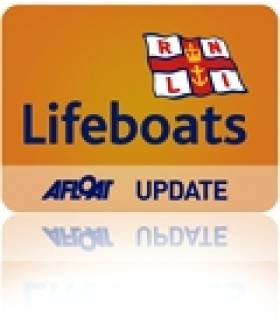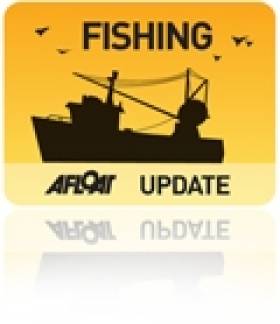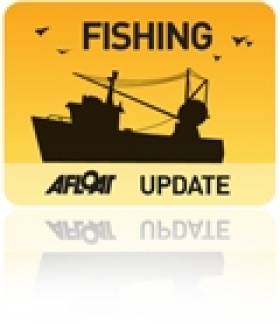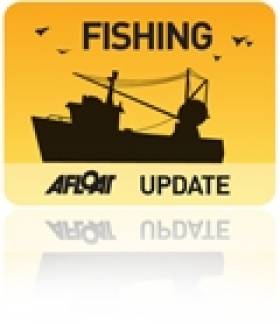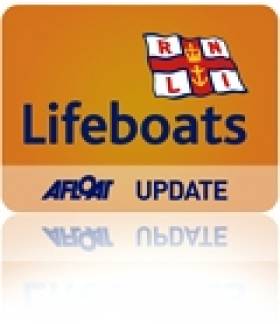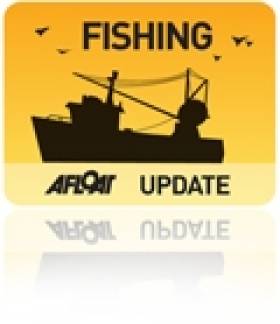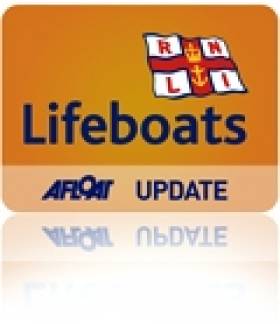Displaying items by tag: Fishing
Fishing Vessels Detained Off Cork & Clare Coasts
#Fishing - BreakingNews.ie reports that two vessels suspected of breaking fishing regulations were detained by the Naval Service in separate incidents yesterday evening (Saturday 12 October).
South of Baltimore in Co Cork, a Spanish registered boat was detained by the LE Aisling, while off Clare a French boat was detained by the LE Eithne. Both were set to be escorted to Gardaí at Castletownbere.
Postmortem Due On Body Recovered Off Inishbofin
#NewsUpdate - Galway Bay FM reports that a postmortem will be carried out today on the body of a fisherman taken recovered the sea off Inishbofin early this morning (Friday 11 October).
The man, from Cill Chiaráin in Co Galway, is believed to have fallen into the water from his fishing boat at some point between 2.30am and 3.30am. Attempts by emergency crews to resuscitate him were unsuccessful.
Dun Laoghaire Lifeboat Rescues Three After Trawler Blaze
#RNLI - Three crew on a disabled fishing trawler were brought to safety by Dun Laoghaire RNLI today (Friday 4 October) after a fire broke out on board the 50-foot vessel.
The incident occurred off Bray Head at 10.30am when the Irish Coast Guard service at Dublin requested the launch of the all-weather lifeboat, which arrived on scene less than 30 minutes later.
The crew on the trawler were able to extinguish the fire but had no power to return to shore.
The lifeboat took the vessel under tow back to Dun Laoghaire in a two-hour operation. Nobody was injured in the incident.
Illegal Bass Netting Prompts Multi-Agency Operation Near Tramore
#Fishing - A duo caught illegally fishing for bass off Tramore put themselves in "extreme danger" by going to sea in an unseaworthy boat.
Staff of Inland Fisheries Ireland (IFI) were working with the Garda investigating illegal netting of fish near Saleens in Co Waterford around 5am on Sunday morning last (25 August) when they came upon the tiny craft, which was not capable of dealing with the sea conditions, and had only one buoyancy aid for its two occupants.
IFI fisheries officers and gardaí were left with no choice but to alert the RNLI and Irish Coast Guard when what began as a fisheries investigation turned into a multi-agency marine search operation.
Thankfully the two people from the tiny craft were later found safely ashore. IFI subsequently seized the small craft and a 120m drift net, along with nine dead bass.
In a statement, IFI emphasised that fishing for bass is illegal, and that such activity has the potential to do huge damage to stocks.
The sale of wild Irish bass is also illegal, and it is important that the public does not support illegal fishing by buying such fish.
A file is being prepared by IFI with a view to prosecuting the fisheries offence.
IFI director David McInerney said it is incredible the risks that are undertaken by people undertaking water based activities.
The area in question is famous for having great stocks of bass and sea trout, but sadly has been the location for a number of tragic drowning’s in recent years.
NI Pays Tribute To Priest Who Pioneered Lough Neagh Eel Industry
#Fishing - Tributes have been paid to the driving force behind Europe's largest wild eel fishery in Lough Neagh.
As the Belfast Telegraph reports, Father Oliver Kennedy passed away yesterday at the age of 83.
Described by NI Agriculture Minister Michelle O'Neill as "an inspirational figure for Lough Neagh fishermen and their families", Fr Kennedy was chairman of the Lough Neagh Fishermen's Co-operative Society.
The priest co-founded the society in 1965 in an effort to assist local eel fishermen in asserting their rights on the lough - including fundraising efforts that enabled the fishermen to take control of Toome Eel Fishery.
The Belfast Telegraph has more on the story HERE.
Spanish Fisherman Airlifted To Hospital in Coastguard Medivac
#Coastguard - Galway Bay FM reports that a man was airlifted by the coastguard from a Spanish fishing trawler off the Galway coast last night (5 August).
The Irish Coast Guard's Shannon-based Rescue 115 helicopter was dispatched to the trawler Brierio some 80 nautical miles west of the Irish coast to retrieve the fisherman, who The Irish Times says was experiencing breathing difficulties.
He was taken to Mid-Western Regional Hospital in Limerick for medical attention.
Fishing Vessel Sought Immediate Naval Assistance
#TrawlerRescue- An Irish registered fishing trawler the Saint Claire sought immediate assistance from the Naval Service when approximately 80 miles west of Dingle Peninsula on Thursday evening.
The OPV L.É. Niamh (P52) responded to the request as the trawler had engineering problems and was unable to generate power. Within an hour of the call the OPV had arrived on the scene.
A team boarded the Saint Claire to assess the situation which led the vessel to be taken under tow to Castletownbere, West Cork. According to the Naval Service all crew are safe and uninjured.
Kilmore Quay & Wicklow RNLI In Separate East Coast Assists
#RNLI - Kilmore Quay RNLI has assisted a fisherman after his boat got into difficulty off the Wexford coast, while Wicklow RNLI attended to a fishing boat in trouble south of Wicklow Harbour.
The Kilmore Quay all-weather lifeboat was requested to launch at 9.04am on Monday morning (29 July) to go to the assistance of a local lobster boat with one person on board,
The fishing boat had fouled its propeller while hauling pots a mile to the south-east of the Little Saltee Island.
Weather conditions at the time were blowing a light southerly breeze and there was good visibility.
When the lifeboat arrived on scene, a tow was set up and the vessel was brought safely to the harbour at Kilmore Quay.
Shortly afterwards, Wicklow RNLI launched at 9.30am in response to a call for assistance from a fishing vessel in difficulties six miles south of Wicklow Harbour.
The vessel with three crew was fishing north of Brittas Bay beach when a rope got fouled in the propeller and she lost steering. The skipper contacted the coastguard for assistance.
Wicklow town's lifeboat, under the command of coxswain Nick Keogh, located the vessel drifting close to the Wolf Rock 20 minutes after launching.
A towline was quickly established and the stricken vessel was towed back to Wicklow Harbour, where she was secured safely alongside the East Pier at 10.40am.
The crew on the call out were coxswain Nick Keogh, mechanic Brendan Copeland, Tommy McAulay, Kevin Rahill, Carol Flahive, Paul Sillery and Graham Fitzgerald.
#Fishing - "Absolutely hammered" is how a Carlingford Lough oyster farmer describes the state of his business after £350,000 (€404,000) worth of his stock was destroyed by a virus in the recent heatwave.
And as the Belfast Telegraph reports, Darren Cunningham now fears financial ruin after at least 80% of his juvenile oysters were wiped out by the ostreid herpes virus, which kills the shellfish when the water temperature rises above 16 degrees.
Unfortunately for Cunningham and fellow oysterman Harold Henning, who fears a total loss of his young oysters, Stormont has no compensation scheme in place for lost stocks in Northern Ireland.
The Belfast Telegraph has more on the story HERE.
#RNLI - The volunteer lifeboat crew of the Courtown lifeboat launched last Wednesday evening (24 July) to a report of a small fishing boat that was overdue on its time to return to Cahore Pier.
The Courtown RNLI lifeboat, Cahore Inshore Rescue, the Rosslare RNLI lifeboat and the Irish Coast Guard helicopter Rescue 117 were all tasked at 7pm to search the area of Cahore on the north Wexford coast, where the boat was last reported fishing.
After searching for some time, the small fishing boat made contact to say they had beached their boat some eight miles north of Cahore Pier at Kilgorman Beach. Both men were safe and well and all rescue services were stood down.
The Courtown lifeboat has since urged all boat users carry a proper means of communication - ideally a VHF radio - and to keep friends and family up to date on their location, especially if they decide to change their location.
That same evening, Rosslare Harbour RNLI was involved in a search for two fishermen after they reported getting into difficulty off the Wexford coast.
The volunteer crew launched their all-weather lifeboat at 7.30pm to assist in the search following a request from the coastguard to attend a fishing boat that was reported to be taking on water.
Weather conditions at the time were described as good, with a southerly force three wind.
The fishing boat had set out from Cahore Harbour before getting into trouble. The two crew raised the alarm using a mobile telephone.
Rosslare Harbour RNLI and lifeboats from Courtown RNLI and Cahore, along with the Rescue 117 helicopter, joined in the search.
At 7.50pm, Rescue 117 located the two fishermen safe and well and their vessel on the beach at Glasgorman, near Cahore.
Speaking after the call-out, Rosslare Harbour RNLI deputy volunteer lifeboat press officer Jamie Ryan said: "The emergency services responded swiftly and were on scene quickly.
"The two fishermen did the right thing by raising the alarm when they got into difficulty and thankfully they were both found safely ashore."




























